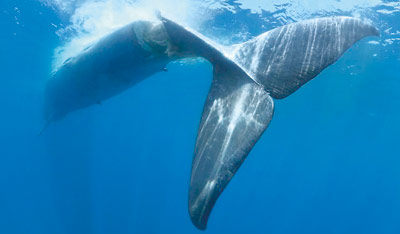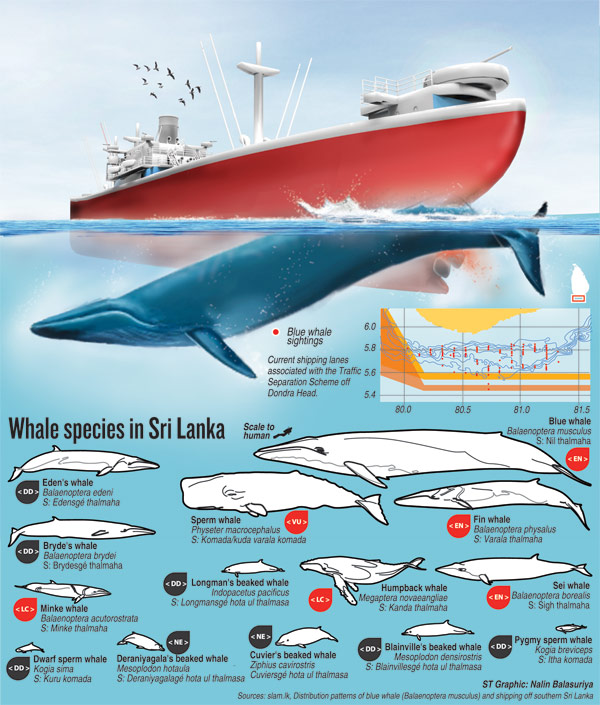News
A whale of a problem; Saving sea giants or saving industry

A Blue Whale hit by a ship in Lankan waters
There was heated debate over the problem of saving whales off Sri Lanka from ship strikes as a three-day forum last week heard the faster speeds at which ships now travel pose a heightened danger to these huge endangered creatures.
A major maritime organisation, however, declared none of its members had ever experienced a ship strike on a whale
A busy shipping route runs through the ocean off southern Sri Lanka which has been identified as an area in which the giant blue whale and many other whales are found in abundance all year around.
A proposal by conservationists to shift this shipping route, known as the Dondra Head Traffic Separation Scheme (TSS), 15 nautical miles (nm) southward is hotly opposed by shipping industry representatives who argue the country’s economy would suffer if this were to happen. Some conservationists too question a shifting of the shipping path.
Last week’s consultative forum organised by the Indian Ocean Marine Affairs Cooperation (IOMAC) focused directly on this issue under the title, “The Environmental Health of the Ocean: First International Expert and Stakeholder Conference on Marine Mammals with special Reference to the issue of Ship-strikes and the IMO Traffic Separation Scheme at Dondra Head”.
The Chairman of the Scientific Sub-Committee on Ship Strikes of the International Whaling Commission (IWC), Dr. Russel Leaper, said whenever a whale path overlapped a shipping route ship strikes were possible.
As ships become bigger and faster, the time a whale has to dodge an approaching ship decreases so ship strikes have become an increasing threat to whales, Dr. Leaper explained.
Dr. Thilak Priyadarshana of the University of Ruhuna and a group of international researchers who published a paper last year called “Distribution patterns of blue whale (Balaenopteramusculus) and shipping off southern Sri Lanka” advocate moving the shipping lane.
Whale researcher Dr. Asha de Vos too believes the whales off Mirissa are vulnerable to ship strikes.
She said the blue whale population off southern Sri Lanka is unique as the whales appear to be staying in our waters throughout the year, a fact that could be attributed to a rich feeding ground.
Dr. de Vos showed the forum photographs of the whale that carried into harbour in 2012 and the horrific underwater images taken by photographer Tony Wu showing a blue whale carcass with a gash cut by a propeller on its tail that could have come from a ship strike.
“Less than 10 per cent of ship strikes are getting reported as the dead whales could sink or be found at a bad stage of decomposition after long time drifting and the reason for the death cannot be confirmed,” she said.
“In some cases, in particular involving large vessels, captains might be unaware that a collision with a cetacean has occurred,” Dr. de Vos explained.
“The whales are in these nearshore areas because these areas are productive and have food. Imagine if there was a bus driving through your kitchen, how would you feel? You would have to go there to get food despite the danger of getting hit.

“The solution to this problem is simple. Shifting the shipping lanes a few nautical miles south of its current position will not really affect the shipping industry but will have huge gains for a species that is very valuable to our economy.
In fact, shipping lanes have been shifted to stop ship-whale collisions in many other parts of the world, so Sri Lanka is not doing anything out of the box or innovative. We will just be doing what is right,” Dr. de Vos stated.
Shipping industry representatives at the forum said they feared moving the shipping route would harm associated industries.
The close proximity of the shipping route to the southern coast of Sri Lanka, in between the two major ports of Galle and Hambantota, brings the opportunity of business from ships passing near the service ports, said Captain Ranjith Weerasinghe of the Company of Master Mariners.
“But ‘out of sight’ would result in ‘out of mind’, so a shift would affect Sri Lanka economically,” he told the IOMAC forum.
“Currently about 1,000 ships per month call for services off the port of Galle as a direct result of having the Traffic Separation System in our coastal proximity.
If this route shifted 15nm it would make the westward passage from Rondo Island coming out of Malacca straight through the Bay of Bengal a direct course to the north of the Maldives, making that the obvious position for shipping services, losing Sri Lanka an opportunity,” Captain Weerasinghe pointed out.
“None of our 275 members, the vast majority of Master Mariners of Sri Lanka, whose sea experience ranges from 12-40 years of sailing, has had a ship strike on a whale ever,” Captain Weerasinghe declared.
Based on the University of Ruhuna study, the NGO, Friends of the Sea, lobbied to push the Sri Lankan government into submitting a proposal to shift the shipping route last year but the government wanted to study the proposal further.
“It is true that we need to conserve the whales, but we should also look at our national interest,” said IOMAC Secretary General Dr. Hiran Jayewardene. He called it as a campaign to prevent ships coming to the ports of Sri Lanka.
“We need hard facts to evaluate whether ship strikes are a very frequent occurrence off southern Sri Lanka that can affect the blue whale population,” he said.
“Even if we move the lane further south, what is the guarantee that it will not affect other populations of whales?” Dr. Jayewardene said.
The Director of Research of the Centre for Research on Indian Ocean Marine Mammals (CRIOMM), Howard Martenstyn, also said there was not enough evidence to determine the ship strikes is a major threat to whales off Mirissa.
Commenting on the 2012 incident where a Bryde’s whale carcass was dragged into harbour on the bow of a vessel, Mr. Martenstyn said that could have been a drifting dead whale carried by the ship.
He said the photograph of a gash wound on the whale could not definitely show whether the whale died due to ship strike or whether a drifting dead whale had been struck with a propeller.
Mr. Martenstyn pointed out there was no significant increase of carcasses found on the southern coast, saying if the whales off Mirissa were regularly hit the number of dead whales found in these areas should show an increase.
Dr. Russell Leaper of the IWC said the accuracy of Sri Lankan whale ship strike records would be reviewed by a panel of international experts over the next few months before being entered into the IWC database and this would resolve some of the confusion between researchers in Sri Lanka over these records.
“Compared to other areas where shipping lanes have been moved to reduce risks to whales, Sri Lanka has a very strong case,” Dr. Leaper said.
“Of all the whale and ship strike problems I have worked on in other areas this is probably the clearest case of the highest risk and also the most straightforward action that could reduce risk.
“We see that moving the passing shipping further offshore could only benefit Sri Lanka. As well as protecting whales it would greatly reduce the risks to whale watching vessels. This is an accident waiting to happen which would have serious consequences for Sri Lanka’s tourist industry.
“Shipping safety would also be improved with lower risk to coastal fishing boats, lower risk of collisions between large ships and less chance of oil spills along the coast. It also allows more space closer to shore for ships using Sri Lankan ports.”
Gehan de Silva Wijeyeratne, who led an aggressive media campaign to brand Sri Lanka for whale-watching, said whale-watching generated much more money than whale watching bookings alone would suggest as customers used the full spectrum of accommodation and other services.
“So whale watching is now a key element for tourism in the south and any move to protect these whales is welcome by the tourism industry,” he said.
“The Indian Ocean blue whale population is low due to extensive illegal whaling in the Indian Ocean in the 1960s.
Furthermore, like many long-lived animals, population recovery can be slow. Therefore every individual that is saved by reducing ship strikes will help conserve these intelligent and sentient beings and help the livelihoods of people in the south,” Mr. Wijeyeratne said.
| Sri Lanka’s whalesNineteen whale species have been recorded in Sri Lankan waters by the Centre for Research on Indian Ocean Marine Mammals (CRIOMM), and there are in total 28 species of marine mammal, including dugong, off our shores. There are two kinds of whales: those with teeth and those that are toothless but have special plates called baleen to filter food. The giant blue whale is a baleen whale. The sperm whale, the largest toothed whale, can live in super pods of more than 100 creatures, a spectacular sight. Off Mirissa, once in a while, are sightings of orcas or so-called killer whales. This is probably the most intelligent marine mammals and, sadly, is often a feature in large aquariums, trained to perform tricks. They have won hearts in films such as Free Willy. Whales are slow breeders so if a number of individuals are killed in a short period of time the recovery of the population is slow. |
-M.R.

